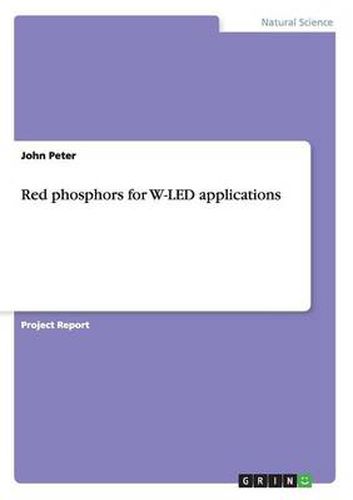Readings Newsletter
Become a Readings Member to make your shopping experience even easier.
Sign in or sign up for free!
You’re not far away from qualifying for FREE standard shipping within Australia
You’ve qualified for FREE standard shipping within Australia
The cart is loading…






Project Report from the year 2015 in the subject Physics - Optics, ST Anne’s College Of Engineering And Technology (St. Anne’s College of Engineering and Technology, Panruti, Tamilnadu, India), language: English, abstract: Trivalent rare-earth-ion-activated molybdate based phosphors have attracted great attention for solid-state lighting applications by virtue of their long lifetimes, and efficient luminescence property. The rare-earth ions are represented by a partly filled 4f shell that is completely shielded by 5s2 and 5p6 orbitals. Therefore, emission transitions provide sharp intense lines in the optical spectra [1, 2]. The use of rare-earth element-based phosphor, based on “line-type” f-f transitions, can narrow the emissions to the visible range, resulting in high efficiency and a high-lumen equivalence. In recent years, a flourishing care is concentrated on Li3Ba2Gd3-x(MoO4)8 host matrix for luminescent ions in the interest of their excellent chemical and thermal stability and favourable luminescence characteristics compared to the sulfide- and nitride-based materials. Moreover, these are environmentally friendly as no toxic gases like sulphide are given out. Li3Ba2Gd3-x(MoO4)8 occur in monoclinic crystal system with space group C2/c in a disordered structure [3]. For this research paper, a series of Li3Ba2Gd3-xPrx (MoO4)8 (x = 0.01, 0.03, 0.05, 0.07and 0.09 mol) and Li3Ba2Gd3-xSmx (MoO4)8 (x = 0.02, 0.04, 0.06, 0.08 and 0.10 mol) red phosphors were synthesized by conventional solid state reaction method.
$9.00 standard shipping within Australia
FREE standard shipping within Australia for orders over $100.00
Express & International shipping calculated at checkout
Project Report from the year 2015 in the subject Physics - Optics, ST Anne’s College Of Engineering And Technology (St. Anne’s College of Engineering and Technology, Panruti, Tamilnadu, India), language: English, abstract: Trivalent rare-earth-ion-activated molybdate based phosphors have attracted great attention for solid-state lighting applications by virtue of their long lifetimes, and efficient luminescence property. The rare-earth ions are represented by a partly filled 4f shell that is completely shielded by 5s2 and 5p6 orbitals. Therefore, emission transitions provide sharp intense lines in the optical spectra [1, 2]. The use of rare-earth element-based phosphor, based on “line-type” f-f transitions, can narrow the emissions to the visible range, resulting in high efficiency and a high-lumen equivalence. In recent years, a flourishing care is concentrated on Li3Ba2Gd3-x(MoO4)8 host matrix for luminescent ions in the interest of their excellent chemical and thermal stability and favourable luminescence characteristics compared to the sulfide- and nitride-based materials. Moreover, these are environmentally friendly as no toxic gases like sulphide are given out. Li3Ba2Gd3-x(MoO4)8 occur in monoclinic crystal system with space group C2/c in a disordered structure [3]. For this research paper, a series of Li3Ba2Gd3-xPrx (MoO4)8 (x = 0.01, 0.03, 0.05, 0.07and 0.09 mol) and Li3Ba2Gd3-xSmx (MoO4)8 (x = 0.02, 0.04, 0.06, 0.08 and 0.10 mol) red phosphors were synthesized by conventional solid state reaction method.